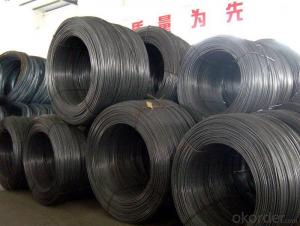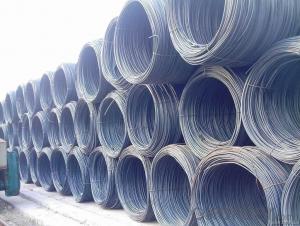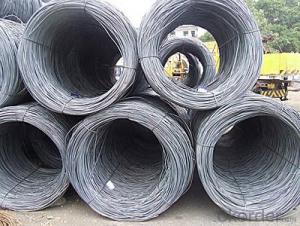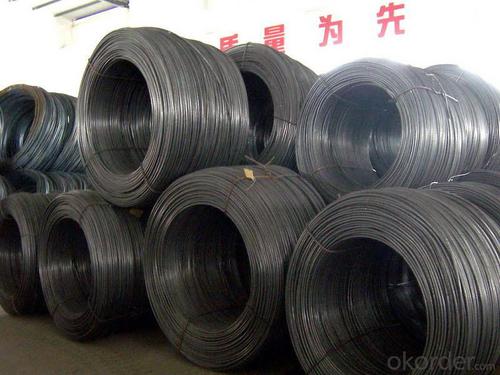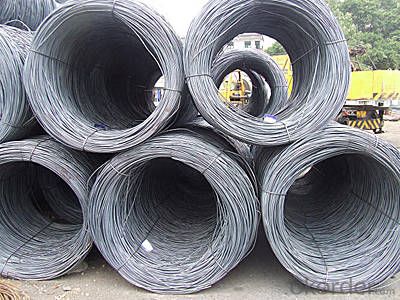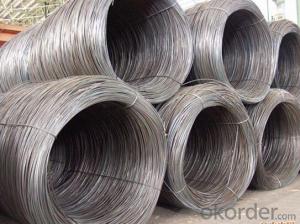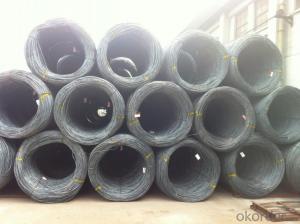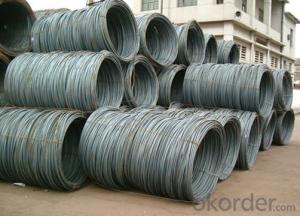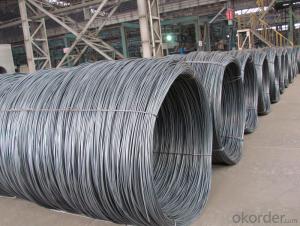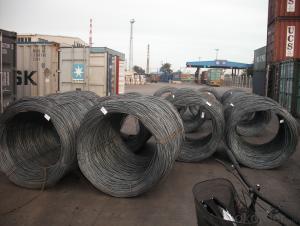Wire Rod High Qulity Hot Rolled Sae 1008b 5.5mmin Coils
- Loading Port:
- Tianjin
- Payment Terms:
- TT or LC
- Min Order Qty:
- 25 m.t.
- Supply Capability:
- 20000 m.t./month
OKorder Service Pledge
OKorder Financial Service
You Might Also Like
Product Description:
OKorder is offering Wire Rod High Qulity Hot Rolled Sae 1008b 5.5mmin Coils at great prices with worldwide shipping. Our supplier is a world-class manufacturer of steel, with our products utilized the world over. OKorder annually supplies products to European, North American and Asian markets. We provide quotations within 24 hours of receiving an inquiry and guarantee competitive prices.
Product Applications:
Wire Rod High Qulity Hot Rolled Sae 1008b 5.5mmin Coils are ideal for structural applications and are widely used in the construction of buildings and bridges, and the manufacturing, petrochemical, and transportation industries.
Product Advantages:
OKorder's Wire Rod High Qulity Hot Rolled Sae 1008b 5.5mmin Coils are durable, strong, and resist corrosion.
Main Product Features:
· Premium quality
· Prompt delivery & seaworthy packing (30 days after receiving deposit)
· Corrosion resistance
· Can be recycled and reused
· Mill test certification
· Professional Service
· Competitive pricing
Product Specifications:
hot rolled sae 1008b wire rod
1 .high quality
2. prompt delivery date
3. competive price and full size
| Product | wire rod |
| Standard | AISI,ASTM,BS,DIN,JIS,GB |
| Grade | Q195,Q235,SAE1006,SAE1008,SAE1018B,H08A,30MnSi,62B-82B |
| Diameter | 5.5mm-14mm |
| Coils weight | around 2 tons |
| MOQ | 100 Metric Ton,also depending on production schedule |
| Delivery Time | 25-45 Days |
| Packing | Standard export packing or as you required |
| Payment term | T/T, L/C |
| Application | construction |
FAQ:
Q1: Why buy Materials & Equipment from OKorder.com?
A1: All products offered byOKorder.com are carefully selected from China's most reliable manufacturing enterprises. Through its ISO certifications, OKorder.com adheres to the highest standards and a commitment to supply chain safety and customer satisfaction.
Q2: How do we guarantee the quality of our products?
A2: We have established an advanced quality management system which conducts strict quality tests at every step, from raw materials to the final product. At the same time, we provide extensive follow-up service assurances as required.
Q3: How soon can we receive the product after purchase?
A3: Within three days of placing an order, we will begin production. The specific shipping date is dependent upon international and government factors, but is typically 7 to 10 workdays.
Q4: What makes stainless steel stainless?
A4: Stainless steel must contain at least 10.5 % chromium. It is this element that reacts with the oxygen in the air to form a complex chrome-oxide surface layer that is invisible but strong enough to prevent further oxygen from "staining" (rusting) the surface. Higher levels of chromium and the addition of other alloying elements such as nickel and molybdenum enhance this surface layer and improve the corrosion resistance of the stainless material.
Q5: Can stainless steel rust?
A5: Stainless does not "rust" as you think of regular steel rusting with a red oxide on the surface that flakes off. If you see red rust it is probably due to some iron particles that have contaminated the surface of the stainless steel and it is these iron particles that are rusting. Look at the source of the rusting and see if you can remove it from the surface.
Images:

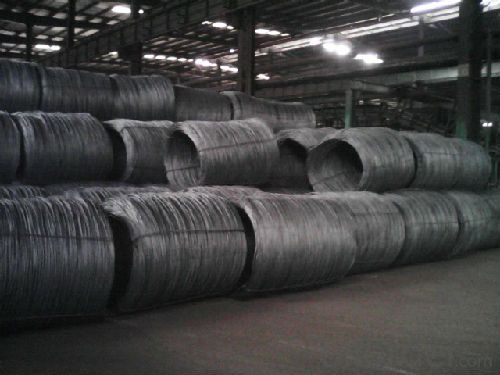
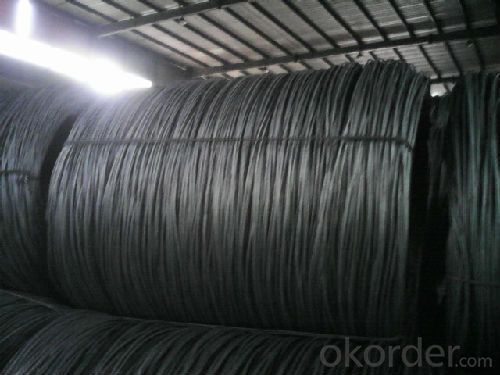
- Q: What are the different types of steel wire rod finishes for improved lubricity?
- There are several types of steel wire rod finishes that can be used to enhance lubricity. These include zinc coating, phosphate coating, galvanizing, and polymer coatings. Zinc coating provides a protective layer and reduces friction, while phosphate coating improves surface adhesion for lubricants. Galvanizing involves applying a layer of zinc to the surface, which increases lubricity. Polymer coatings create a smooth and low-friction surface, further enhancing the lubricity of the steel wire rod.
- Q: How does the tensile strength of steel wire rod vary with different wire drawing processes?
- The tensile strength of steel wire rod can vary significantly depending on the specific wire drawing process used. Wire drawing is a metalworking process that involves reducing the diameter of a wire by pulling it through a series of dies. Different wire drawing processes, such as cold drawing, hot drawing, and intermediate drawing, can have different effects on the tensile strength of the steel wire rod. During cold drawing, the steel wire rod is pulled through a die at room temperature. This process can increase the tensile strength of the wire rod significantly. Cold drawing aligns the metal's crystalline structure, which results in increased strength and hardness of the wire. The wire is also likely to have a smooth and uniform surface finish due to the cold drawing process. Hot drawing, on the other hand, involves pulling the steel wire rod through a die at elevated temperatures. This process can also increase the tensile strength of the wire rod, but to a lesser extent compared to cold drawing. Hot drawing allows for greater plastic deformation of the steel, resulting in improved ductility and reduced brittleness. The wire produced through hot drawing may have a rougher surface finish due to the higher temperatures involved. Intermediate drawing is a combination of both cold and hot drawing processes. In this process, the steel wire rod is initially subjected to hot drawing and then cold drawing. This combination allows for greater control over the mechanical properties of the wire, including tensile strength. Intermediate drawing can result in a wire with improved strength and ductility, as the hot drawing process improves plastic deformation and the cold drawing process aligns the crystalline structure. In summary, the tensile strength of steel wire rod can vary with different wire drawing processes. Cold drawing generally results in the highest increase in tensile strength due to the alignment of the crystalline structure. Hot drawing and intermediate drawing processes also increase strength but to a lesser extent, while providing other benefits such as improved ductility and reduced brittleness. The specific wire drawing process chosen depends on the desired mechanical properties and surface finish of the wire.
- Q: How is steel wire rod used in the manufacturing of wire for electrical applications?
- The manufacturing of wire for electrical applications heavily relies on steel wire rod, a vital component. This rod serves as the primary raw material and goes through various processes to become the final wire product. At the outset, steel wire rod is typically made from carbon or alloy steel, known for its exceptional strength and durability. It is commonly produced in large coils or bundles, allowing for efficient transportation and handling during manufacturing. The initial step in the use of steel wire rod for electrical wire manufacturing involves the drawing process. In this process, the rod is passed through a series of dies that gradually reduce its diameter. This drawing process refines the steel's structure, aligns its grain boundaries, and enhances its mechanical properties like tensile strength and ductility. Once the desired diameter is achieved, the drawn wire undergoes further processing to enhance its conductivity for electrical applications. This is usually accomplished through the annealing process, where the wire is heated and then slowly cooled. Annealing relieves any internal stress or strain in the wire, making it more flexible and conductive. Following annealing, the wire may undergo additional surface treatments, such as coating or plating, to improve its corrosion resistance or provide specific electrical properties. These treatments involve the application of various metals or insulating materials, depending on the specific requirements of the electrical application. Ultimately, the wire is spooled or coiled into specific lengths and packaged for distribution to various industries that utilize electrical wire. These industries span from power generation and distribution to telecommunications, automotive, electronics, and many others. In conclusion, steel wire rod plays a critical role in the manufacturing of wire for electrical applications. It undergoes processes like drawing, annealing, and surface treatments to transform it into a high-quality wire with exceptional mechanical and electrical properties. As a result, it becomes a versatile product suitable for a wide range of electrical applications, ensuring the efficient and reliable transmission of electricity.
- Q: How does steel wire rod compare to other materials for similar applications?
- Steel wire rod is highly regarded for its exceptional strength, durability, and versatility, making it a superior choice when compared to other materials for similar applications. Its high tensile strength and excellent resistance to corrosion and heat allow for a wide range of uses, including construction, automotive, and manufacturing industries. Additionally, steel wire rod offers excellent flexibility and malleability, allowing it to be easily manipulated into various shapes and sizes. Its cost-effectiveness and wide availability further contribute to its superiority over other materials, making steel wire rod the preferred option for many applications.
- Q: What are the common industry qualifications for steel wire rod distributors?
- The common industry qualifications for steel wire rod distributors include having a strong understanding of the steel industry and its products, knowledge of various types of steel wire rods, proficiency in supply chain management and logistics, excellent communication and negotiation skills, and a proven track record of successfully distributing steel wire rods to clients. Additionally, some distributors may also have certifications or memberships in industry associations that demonstrate their commitment to quality and adherence to industry standards.
- Q: What are the common production processes for carbon-coated steel wire rod?
- Some common production processes for carbon-coated steel wire rod include wire drawing, cleaning and coating the steel rod with carbon, annealing to improve its strength and flexibility, and finally, cutting the rod into desired lengths.
- Q: How are steel wire rods used in the production of fishing lines for catching fish?
- Steel wire rods play a vital role in making fishing lines for capturing fish. These wire rods are used to construct the core of the fishing line, imparting the strength and durability needed to endure the tension and pressure exerted by large fish during the catching process. To manufacture fishing lines, the steel wire rods go through a series of procedures. Firstly, the rods are passed through a set of dies to reduce their diameter and increase their length. This wire drawing process results in thinner and longer wire rods, which are more manageable and practical to work with during fishing line production. Once the wire rods are drawn, they receive a layer of protective material, such as nylon or polyethylene, to enhance their resistance against abrasion, UV rays, and water damage. This coating also enhances the line's overall flexibility and knot strength, ensuring its reliability for fishing purposes. Following the coating process, the steel wire rods are then twisted or braided together to form the fishing line. The number of wire rods used and the specific twisting or braiding technique employed vary depending on the desired strength, thickness, and characteristics of the fishing line. The resulting fishing line is renowned for its exceptional strength, durability, and resistance to breakage. It can endure the harsh conditions of fishing, including sharp rocks, strong currents, and the vigorous movements of fish, without compromising its integrity. This makes it an indispensable tool for anglers, empowering them to confidently target and catch a diverse range of fish species. In conclusion, steel wire rods are indispensable in the production of fishing lines due to their provision of essential strength and durability required for successful fish catching. The wire rods undergo drawing, coating, and twisting or braiding processes to create fishing lines that are robust, flexible, and resistant to the elements, thereby enabling anglers to enjoy a dependable and efficient fishing experience.
- Q: What are the different types of steel wire rod testing equipment?
- There are several types of steel wire rod testing equipment used to ensure the quality and performance of these materials. Some of the common types of equipment include: 1. Tensile testing machine: This equipment is used to measure the tensile strength of steel wire rods. It applies a pulling force on a sample of the wire rod until it breaks, allowing for the determination of the maximum amount of force the wire rod can withstand. 2. Hardness tester: This instrument measures the hardness of the steel wire rod, which is an important property for determining its strength and durability. There are various types of hardness testers, including Rockwell, Brinell, and Vickers hardness testers, which use different methods to assess the hardness of the material. 3. Ultrasonic testing equipment: Ultrasonic testing is a non-destructive method used to detect internal defects and flaws in steel wire rods. This equipment uses high-frequency sound waves to identify any abnormalities that may affect the quality and integrity of the material. 4. Dimensional measurement tools: These tools are used to measure the dimensions and tolerances of steel wire rods accurately. They can include devices such as micrometers, calipers, and gauges to ensure that the wire rods meet the required specifications. 5. Surface inspection equipment: This equipment is used to visually inspect the surface of the steel wire rods for any defects, such as cracks, scratches, or irregularities. Visual inspection can be done manually or with the help of automated systems that use cameras and computer algorithms to detect and analyze surface defects. 6. Chemical composition analyzer: This equipment is used to determine the chemical composition of the steel wire rods. It analyzes the presence and concentration of various elements, such as carbon, manganese, silicon, and others, to ensure that the wire rods meet the required composition standards. These are just a few examples of the different types of testing equipment used for steel wire rods. Each type plays a crucial role in ensuring the quality, strength, and performance of these materials in various industries, including construction, automotive, and manufacturing.
- Q: How is steel wire rod used in the manufacturing of wire for wind turbines?
- Steel wire rod is a crucial component in the manufacturing of wire for wind turbines as it forms the base material for making the wire. The wire rod is first processed through various stages, including drawing and annealing, to enhance its strength and flexibility. Once the wire is formed, it is utilized in wind turbine applications, such as the construction of electrical windings, cables, and structural components. The high tensile strength of steel wire rod ensures that the wire can withstand the demanding conditions within wind turbines, contributing to their overall efficiency and reliability.
- Q: How are steel wire rods used in the production of wire hangers?
- Wire hangers rely on steel wire rods as essential components in their production. These rods, serving as the raw material, are transformed into wire hangers through a process involving drawing and processing. The steel wire rods are initially processed and passed through a series of dies to achieve the desired thickness and shape, thereby enhancing the wire's strength and durability. Subsequently, the wire rods are cut into specific lengths to form individual hangers. These hangers are then bent and shaped into their familiar form. The malleability of steel wire rods enables manufacturers to easily manipulate and customize wire hangers, resulting in a variety of styles and sizes to meet diverse needs. By employing steel wire rods, manufacturers ensure the creation of sturdy and dependable hangers capable of effectively supporting garments.
Send your message to us
Wire Rod High Qulity Hot Rolled Sae 1008b 5.5mmin Coils
- Loading Port:
- Tianjin
- Payment Terms:
- TT or LC
- Min Order Qty:
- 25 m.t.
- Supply Capability:
- 20000 m.t./month
OKorder Service Pledge
OKorder Financial Service
Similar products
Hot products
Hot Searches
Related keywords
